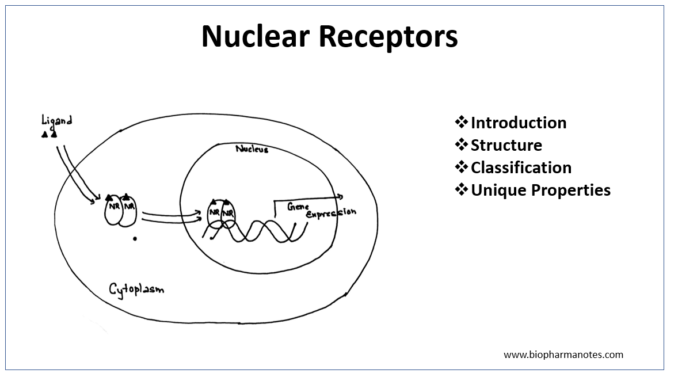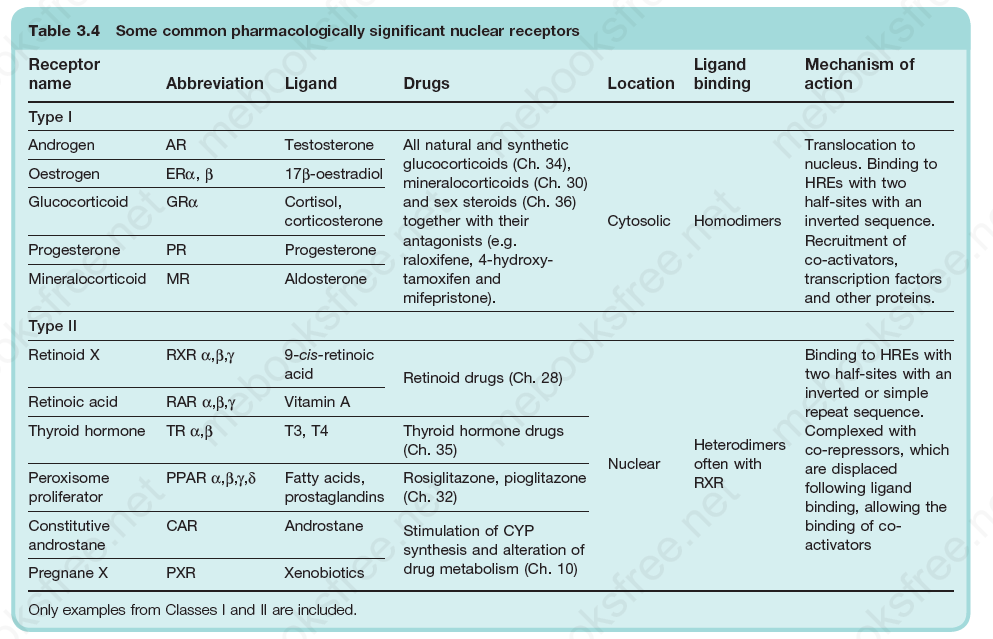
- Nuclear receptors (NRs) are a class of proteins which respond to intra and extracellular signal carried by steroid or thyroid hormones leading to regulation of expression of target genes. They are one of the largest known superfamilies of eukaryotic transcription factor and are found either in cytoplasm (type I) or in nucleus (type II).
- They were first described as ligand- regulated DNA binding transcription factors. Estrogen receptor is first member of this family to be identified biochemically.
- They play different roles in maintaining normal physiology of cells including metabolism, electrolyte balance, enzyme activity, development and reproduction.
Structure of nuclear receptors

Figure- Domain structure of nuclear receptors (Source- Mazaira et al. 2018)
- All nuclear receptors are monomeric proteins. Molecular weight may be around 50-100 kDa.
- They contain N-terminal activation domain, a highly conserved central region zinc-finger DNA binding domain and C-terminal domain to which ligand binds. N-terminal activation domain is the most heterogeneous one. It contains at least one constitutionally active transactivation region (AF-1). DNA-binding domain consist of two zinc fingers- cysteine- rich loops in the amino acid chain held in particular confirmation by zinc ions. This portion is responsible for recognizing and binding to the hormone response elements (HRE) and for receptor dimerization which is important for function of most NRs. C-terminal domain is specific to each class of receptor. It also plays important role in dimerization and binding co-activator and co-repressor proteins.
Classification of Nuclear receptors
Class I nuclear receptor
- Class I nuclear receptor also known as steroid receptor includes estrogen receptor, progesterone and androgen receptors, glucocorticoid receptor and mineralocorticoid receptor. When not attached to ligand, they are mostly located in cytoplasm complexed with heat shock and other proteins. Once ligand binds, they generally form homodimers and are translocated to nucleus. In nucleus they bind to positive or negative HREs and transactivate or transrepress genes.
Androgen receptors– they are activated by testosterone and dihydrotestosterone. Ligands bind to AR in cytosol of a cell, translocate to nucleus and alter transcription resulting in protein synthesis, formation of gonads, development of secondary sex characters etc.
Glucocorticoid receptors– Agonists are cortisol and other glucocorticoids. After binding of agonist, they can either up-regulate or repress transcription. They help to maintain homeostasis of physiological process including immune function, skeletal growth, CVS function and reproduction.
Class II nuclear receptor
Class II nuclear receptors include thyroid hormone receptors (TRα and β), retinoid acid receptors, peroxisome proliferator activated receptors (PPARα) and vitamin D receptors. They mostly operate as heterodimers with retinoid X receptor. There are two types of heterodimers:
Non-permissive heterodimers which can be activated only by the ligand of retinoid X receptors.
Permissive heterodimer which can be activated by retinoic acid itself or its partner’s ligand.
They generally bind to co-repressor proteins.
Thyroid hormone receptors– They are activated by binding of thyroid hormones and helps in regulation of metabolism, development and heart rate. Reduced stimulation of thyroid hormone receptors causes hypothyroidism whereas hyperthyroidism may be caused by increase in TR stimulation.
Peroxisome Proliferator activated receptor α (PPARα)- Endogeneous ligands include fatty acids such as arachidonic acid, other polyunsaturated fatty acid. After binding to ligand, they lead to increase in lipoprotein lipase which causes decrease in production of hepatic triglyceride. Fibrates- drugs used in hyperlipidemia are PPARα agonist.
Orphan Nuclear receptors
- Orphan nuclear receptors are nuclear receptors whose endogenous ligands have not been identified. Most of them bind to their target DNA elements as monomer or homodimers. Some example includes small heterodimer partner (SHP), testicular receptor 2 and 4 (TR2 and 4), estrogen related receptor, neuron derived orphan receptor 1 (NOR1) and germ cell nuclear factor.

Unique properties compared to other receptors
- They can interact with DNA directly and modify gene transcription. Hence, they play important role in regulation of metabolic, developmental, and other critical processes.
- They are not generally embedded in membrane like GPCR and other receptors. They are located in other compartment of cells.
References
- Mazaira Gi et al. The Nuclear Receptor Field: A Historical Overview and Future Challenges. Nucl Receptor Res. 2018; 5: 101320.
- https://jcs.biologists.org/content/116/4/585
- Rang and Dales Pharmacology. 9th edition.